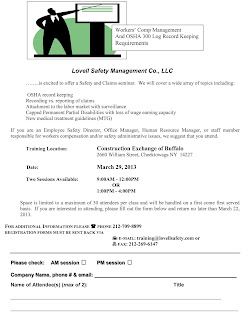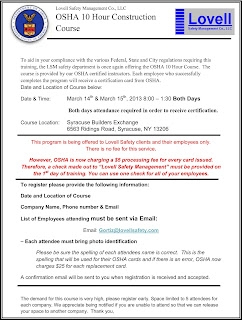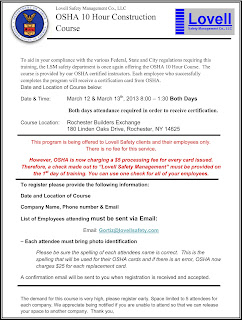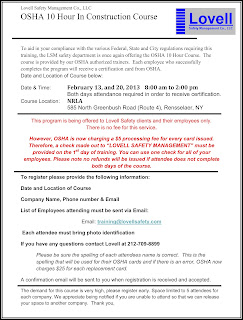With
the threat of a severe winter storm hitting the New York area, the Safety
Department of Lovell Safety Management wants to remind you that our priority is
to ensure that you stay safe. With that in mind, please read the following and
link to whatever winter safety topic is relevant for you. If you have
questions, please call the Safety Department at 212-709-8899 or email us at safety@lovellsafety.com.
Winter
storms create a variety of hazards and can have lingering impacts on everyday
tasks and work activities. According to the National Weather Service, about 70
percent of injuries during winter storms result from vehicle accidents, and
about 25 percent of injuries result from being caught out in the storm. Learning
about how to prepare for a winter storm and avoid hazards when one occurs will
help keep you safe during the winter season.
Employer
Responsibilities and Workers’ Rights
Each
employer is responsible for the safety and health of its workers and for
providing a safe and healthful workplace for its workers. Employers are required
to protect workers from the anticipated hazards associated with the winter storm
response and recovery operations that workers are likely to
conduct.
While
most workers can stay inside during a winter storm, some workers may be required
to go into the storm. These may include utility workers; law enforcement
personnel; firefighters; emergency medical personnel; federal, state and local
government personnel; military personnel; highway personnel; and sanitation
workers.
Some
of the hazards associated with working in winter storms include:
What
should I do if a winter storm strands me in my vehicle?
Stay
in the vehicle. Do not leave the vehicle to search for assistance unless help is
visible within 100 yards. You may become disoriented and lost in blowing and
drifting snow. Display a trouble sign by hanging a brightly colored cloth on the
radio antenna and raising the hood. Turn on the vehicle’s engine for about 10
minutes each hour and run the heat to keep warm. Also, turn on the vehicle’s
dome light when the vehicle is running as an additional signal. Beware of
carbon monoxide poisoning. Keep the exhaust pipe clear of snow, and open a
downwind window slightly for ventilation.
Watch
for signs of frostbite and hypothermia. Do minor exercises to keep up
circulation. Clap hands and move arms and legs occasionally. Try not to stay in
one position for too long. If more than one person is in the vehicle, take turns
sleeping. For warmth, huddle together. Use newspapers, maps, and even the
removable car mats for added insulation. Avoid overexertion since cold weather
puts an added strain on the heart. Unaccustomed exercise such as shoveling snow
or pushing a vehicle can bring on a heart attack or make other medical
conditions worse. Be aware of symptoms of dehydration.
Frostbite
and Hypothermia
What
is frostbite?
Frostbite
is a severe reaction to cold exposure that causes freezing in the deep layers of
skin and tissue. Frostbite can cause permanent damage. It is recognizable by a
loss of feeling and a waxy-white or pale appearance in fingers, toes, nose, or
ear lobes. For more information, see OSHA’s Cold
Stress Safety and Health Guide, or OSHA’s publication, The Cold Stress
Equation (also available as a 21 KB PDF, 4
pages).
What
is hypothermia?
Hypothermia
occurs when the body temperature drops to less than 95°F. Symptoms of
hypothermia include uncontrollable shivering, slow speech, memory lapses,
frequent stumbling, drowsiness, and exhaustion. For more information, see OSHA’s
Cold
Stress Safety and Health Guide, or OSHA’s publication, The Cold Stress
Equation (also available as a 21 KB PDF, 4
pages).
Shoveling
Snow
What
hazards are associated with activities to shoveling snow?
Shoveling
snow can be a strenuous activity, particularly because cold weather can be
taxing on the body, and can create the potential for exhaustion, dehydration,
back injuries, or heart attacks. In addition to following the tips for avoiding
frostbite and hypothermia, such as taking frequent breaks and drinking fluids
(while avoiding ones with caffeine or alcohol), there are a variety of other
precautions workers can take to avoid injuries while removing snow. Workers
should warm-up before the activity, scoop small amounts of snow at a time, push
the snow instead of lifting where possible, and user proper form if lifting is
necessary: keeping the back straight and lifting with the
legs.
How do
I walk safely on snow and ice?
Where
appropriate, clear walking surfaces of snow and ice and use salt or its
equivalent. In addition, the following precautions will help reduce the
likelihood of any injuries:
§
Walking
on snow or ice is especially treacherous and wearing proper footwear is
essential. A pair of well insulated boots with good rubber treads is a must for
walking during or after a winter storm. Keeping a pair of rubber over-shoes with
good treads which fit over your street shoes is a good idea during the winter
months.
§
When
walking on an icy or snow-covered walkway, take short steps and walk at a slower
pace so you can react quickly to a change in traction.
§
When
walking on a sidewalk which has not been cleared and you must walk in the
street, walk against the traffic and as close to the curb as you can.
§
Be on
the lookout for vehicles which may have lost traction and are slipping towards
you. Be aware that approaching vehicles may not be able to stop at crosswalks or
traffic signals.
§
At
night, wear bright clothing or reflective gear, as dark clothing will make it
difficult for motorists to see you.
§
During
the daytime, wear sunglasses to help you see better and avoid hazards.
Repairing
Downed or Damaged Power Lines and Removing Downed Trees
What
hazards are associated with repairing downed or damaged power
lines?
The
work activities involved with repairing downed or damaged lines entail many of
the activities involved in installing and removing overhead lines and in general
maintenance on overhead lines. The crucial difference is that in emergency
conditions, such as winter storms, there are unknown hazards and the potential
for changing hazards as work progresses. Under these conditions workers must be
extra vigilant and cautious.
Potential
hazards include:
–
Electrocution
by contacting downed energized lines, or contacting objects, such as broken tree
limbs, in contact with fallen lines.
– Falls
from heights.
–
Being
struck or crushed by falling poles, towers or parts thereof, tree limbs, ice
accumulation on lines, towers and poles.
–
Being
injured in vehicular accidents when responding to an emergency situation.
–
Burns
from fires caused by energized line contact or equipment failure.
What
protective measures should be utilized when working on or around downed or
damaged power lines?
Assume
all power lines are energized and stay well clear of any downed or damaged power
lines. Establish a safe distance from the lines and report the incident to the
responsible authority. Only properly-trained electrical utility workers should
handle damaged power lines.
Electrical
utility workers should first assess the hazards present in order to minimize the
chances of exacerbating the situation. Ideally the lines involved should be
de-energized, but this may not be possible in all
situations.
When
working on downed or damaged power lines, electrical workers should utilize
proper electrical safety work practices and personal protective equipment, as
usual. However, as mentioned previously, extra caution should be exercised when
working in winter storms, due to the adverse conditions
present.
What
hazards exist during removal of downed trees during a winter storm, and what
safety precautions should be taken?
Clearing
downed trees is a critical job during a winter storm. When winter storms occur,
downed trees can block public roads and damage power lines. Emergency crews are
often sent out to clear downed trees during a winter
storm.
Potential
hazards include:
–
Electrocution
by contacting downed energized lines or contacting broken tree limbs in contact
with fallen lines.
–
Falls
from trees.
–
Being
struck or crushed by falling tree limbs or ice.
–
Being
injured by emergency equipment such as chain saws and chippers.
Proper
PPE including gloves, chaps, foot protection, eye protection, fall protection,
hearing protection and head protection should be worn by workers using chainsaws
and chippers to clear downed trees.
Only
appropriate power equipment that is built to be used outdoors and in wet
conditions should be used. All saws, chippers, and other tools should be used
properly and according to their intended application. It is important that all
equipment is well-maintained and functioning correctly in order for use. In
addition, all equipment should have proper guarding, working controls, and other
safety features as installed by the manufacturer.
Powered
Equipment and Snow Blowers
What
are the potential hazards of using powered equipment and snow blowers, and what
precautions should be taken?
It is
important to make sure that powered equipment, such as chain saws or other power
tools, are properly grounded. When performing maintenance or cleaning, make sure
that the equipment is properly guarded and is disconnected from power
sources.
Snow
blowers commonly cause lacerations or amputations when operators attempt to
clear jams. Never attempt to clear a jam by hand. First, turn the machine
off and wait five seconds, and then use a long stick to clear wet snow or debris
from the machine. Keep your hands and feet away from moving parts. Additionally,
refuel a snow blower prior to starting the machine; do not add fuel to a running
or hot engine.
Clearing
Snow from Roofs and Working at Heights
Stay
Safe






